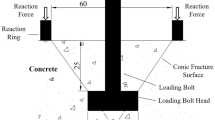Abstract
Compressive strength data representing concrete used to slipform the water tower shaft were evaluated. The evaluation was performed utilizing the computer model, the complete quality control report (CQC Report), which was set up on the basis of the project specification, and statistical methods and criteria given in ACI 214-77. A continuing record of the strength data was maintained and analysed for individual strength tests, cumulative average, moving average, average required strength, overall standard deviation, coefficient of variation, ranges of individual tests, moving range, within-test coefficient of variation, and the adequacy of control over concrete and testing operations. The test data were used for three main purposes: (a) to assist the batch plant in the production of uniform, high quality concrete for slipforming; (b) to determine the adequacy of testing procedures, and (c) towards establishing and refining the statistical relationships for future similar projects.
An early indication of the quality of concrete, which is vital for continuous slipforming, was obtained by estimating the predicted 28-day strengths using 1-, 3- and 7-day data and the strength-maturity relationship developed in accordance with ASTM C 918. Based on the total weighted percentage average errors and the integral absolute error it appears that all three sets of early strentth data were approximately equal in their validity as prediction bases. Analyses of test results show that the same prediction equation which was used to determine the potential 28-day strength can also be used, in the reverse form, to specify the early strength criterion for quality control purposes, provided that the data are normally or near normally distributed.
Using CQC Report it was possible to process and analyse the vast amount of data in a very short time, and to provide the slipform contractor with key information regarding the probable quality of the concrete as placed. This allowed the contractor to note immediately a descending trend in quality of the concrete, to make corrective adjustments in the manufacturing process and to continue concreting with a high degree of confidence.
Resume
On a évalué les données de résistance à la compression correspondant au béton utilisé pour coffrer le noyau du château d'eau. Pour cette évaluation, on s'est servi du modèle de calcul du ‘rapport assurance de la qualité (CQC Report) qui a été établi sur la base du cahier des charges du projet et sur les méthodes statistiques et les critères fournis par la spécification ACI 214-77. On a assuré et analysé un enregistrement continu des données de résistance pour des essais individuels: moyenne cumulative, moyenne flottante, résistance moyenne requise, déviation totale normale, coefficient de variation au cours de l'essai, adéquation du contrôle du béton et du déroulement des essais. On a utilisé les données d'essai dans trois buts principaux: (a) venir en aide à l'usine de production afin d'obtenir un béton uniforme de haute qualité pour le coffrage; (b) déterminer la pertinence des procédures d'essai; (c) établir et raffiner les relations statistiques pour des projets similaires dans le futur.
On a obtenu une indication rapide de la qualité du bétonce qui est vital pour un coffrage glissant—en évaluant la relation déformation/maturité développée selon ASTM C 918. En s'appuyant sur le pourcentage total d'erreurs moyennes et l'erreur intégrale absolue, il ressort que les trois données de résistance obtenues rapidement étaient à peu près également satisfaisantes comme bases prévisionnelles. Les analyses des résultats d'essai montrent que l'équation de prédiction utilisée pour déterminer la résistance potentielle à 28 jours pouvait aussi l'être, dans sa forme renversée, afin de spécifier le critère de résistance précoce pour effecteur des contrôles de qualité, pourvu que les données soient distribuées normalement ou presque.
A l'aide du CQC Report, on a pu traiter et analyser une quantité importante de données en un temps très court, et fournir à l'entrepreneur chargé du coffrage des informations essentielles sur la qualité du béton en place. Ainsi celui-ci a-t-il pu repérer immédiatement une baisse de qualité du béton, apporter les ajustements nécessaires dans le processus de fabrication et continuer cette fabrication avec un niveau de confiance élevé.
Similar content being viewed by others
References
Novokshchenov, V., ‘The complete quality control report’,Concr. Int. 10 (1988) 35–40.
Novokshchenov, V., and Allum, D., ‘Monitoring concrete operations with CQC Report’,Concr. Int. 14 (1992) 51–57.
‘ACI Committee 214, Recommended Practice for Evaluation of Strength Test Results of Concrete, ACI 214-77’, ‘ACI Manual of Concrete Practice 1933’, Part 2 (American Concrete Institute, Detroit).
‘Standard Method for Developing Early Age Compression Test Values and Projecting Later Age Strengths, ASTM C918-80’, ‘1986 Annual Book of ASTM Standards’, V. 04.02 (ASTM, Philadelphia) pp. 589–594.
‘ACI Committee 318, Building Code Requirements for Reinforced Concrete, ACI 318-83’, ‘ACI Manual of Concrete Practice 1989’, Part 3 (American Concrete Institute, Detroit) p 318.
Kelsi, F., ‘Computer Aided Analysis and Prediction of Concrete Cylinder Strengths (in Accordance with ACI 214-77), ACI SP-101’ (American Concrete Institute, Detroit, 1987) pp. 99–123.
‘ACI Committee 214, Recommended Practice for Evaluation of Compression Test Results of Field Concrete (ACI 214-65), ACI SP-37’ (American Concrete Institute, Detroit, 1973) pp. 117–145.
Pzydek, T., ‘An SPC Primer’ (Quality America, Inc., Tucson, AZ, 1984) pp. 47, 52.
Besterfield, D. H., ‘Quality Control’ (Prentice-Hall, Englewood Cliffs, NJ, 1986) pp. 341–342.
Author information
Authors and Affiliations
Rights and permissions
About this article
Cite this article
Novokshchenov, V. Computer aided evaluation of concrete strength data at the water tower project in Al Kharj, Saudi Arabia—Case study. Materials and Structures 28, 267–275 (1995). https://doi.org/10.1007/BF02473261
Issue Date:
DOI: https://doi.org/10.1007/BF02473261




